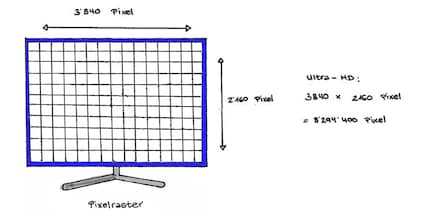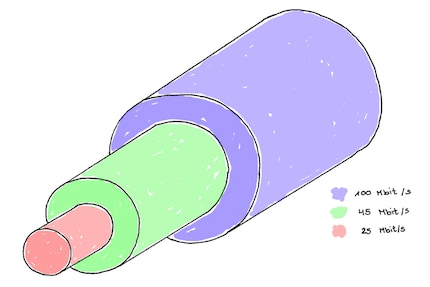
Background information
How big is a pixel?
by Luca Fontana
Picture resolutions are developing rapidly. 4K and Ultra HD are only just becoming established and 8K televisions are already on the shelves. But even the best 8K TV is useless if one thing isn't right: The data transmission.
Some technologies are developing faster than they can become established. Picture resolution, for example. 4K and Ultra HD are not yet so widespread, but Samsung is already presenting the first 8K televisions.
This is happening too quickly. Because before a new format can establish itself, it has to overcome three hurdles.
Making devices that can handle four times the resolution of Ultra HD (UHD) is not the hard part. Nor is finding such high-resolution content. It is the transferability of the content to the playback device that determines the success or failure of a new format.
In order for image resolutions such as UHD or even 8K to be displayed, a compatible playback device is required. Televisions. Monitors. Billboards. The resolution is not the result of any software that calculates small pixels. Nor can it be added via a firmware update. The image resolution is physically present, in the form of pixels. Always. In other words: The higher the resolution, the more pixels are installed on the screen.

The difficulty lies in building pixels that are small enough to fit on the surface of a television. With a 65-inch display, a UHD pixel would have a width and height of 0.375 millimetres. For an 8K display, it would be 0.175 millimetres. Incidentally, a pixel consists of three sub-pixels, which together mix the colour of the pixel. Manufacturers therefore do not build pixels, but subpixels that are only a third of the size of the pixel. That is 0.125 millimetres for UHD and 0.058 millimetres for 8K displays.
It's getting crazier and crazier.
Despite the difficulties, this first hurdle is easy to overcome. Samsung is currently leading the 8K race. The South Korean manufacturer has been offering the first UHD-2 TV for home cinema since autumn 2018. UHD-2 - that's the name for the 8K format in home cinema. At least until someone has a better idea than simply sticking a two after "UHD".
The tragic thing is that it's not the sheer mass of pixels that determines how good the picture looks to the viewer.
A UHD 2 TV without suitable content, i.e. films and series in 8K, is nothing more than a UHD TV with a few thousand francs in pixels stuck to it. That's why the second hurdle is critical.
The easiest UHD 2 source to achieve is "upscaling". This is the upscaling of Full HD or Ultra HD content. This is done by bilinear interpolation: The total number of pixels is increased by adding missing pixels. The image processor does the maths. The more power the processor has, the better the upscaling quality. However, a lot of image information has to be invented and copied. Upscaled content therefore never looks as good as content that is available in UHD 2 quality from the outset.
Upscaling as the only 8K/UHD 2 source therefore cannot work. It needs real moving footage that has been recorded with appropriate video cameras. That is a problem. Red is one of the leading companies in Hollywood for the production of film cameras. And they are one of the few who produce 8K cameras at all.
With their 8K cameras, films such as "Guardians of the Galaxy Vol. 2" or the upcoming "Mortal Engines". Maybe you know even more. But that's about it. Hollywood still sees little reason for 8K. Most cinema projectors project a 2K image. Even 4K cinemas are rare: The Onyx Cinema in auditorium 5 of the Cinema Arenas in the Sihlcity shopping centre, Zurich, is a rarity in Switzerland. And you don't even need to look for 8K cinemas outside of IMAX film theatres.
The biggest problem when dealing with 8K content is the sheer amount of image information that is captured in video files. Large-scale Hollywood productions run into the hundreds of terabytes or even petabytes. This brings hardware and software to their knees. Servers. Computers. Cutting programmes. It is expensive to provide resources that can handle such huge amounts of data efficiently.
Once the first two hurdles have been overcome, the question remains as to how the material gets to the TV. In other words, data transmission. Efficient transmission depends on the bandwidth. This applies to both internet and cable transmission. And the challenge posed by the Gotthard Tunnel between the cantons of Uri and Ticino is not so dissimilar.
Imagine this tunnel
Metaphorically speaking, it is the bandwidth. The cars travelling through it are the data volume. If the bottleneck is too small, the cars will only make slow progress. Traffic jam. This is exactly what happens to data when the bandwidth is too small. It can't get to your TV fast enough. Videos start to stutter until at some point nothing runs at all and the system gives up due to overload.

The amount of data for 4K and UHD content is huge. In the Blu-ray sector, televisions are already equipped to handle this. It needs an HDMI 2.1 connector - which most people have - and an 8K-capable HDMI cable with a transmission rate of 48 gigabits per second. That's no problem either.
The problem is that there are no UHD 2 Blu-rays or will be in the foreseeable future.
That leaves streaming portals such as Netflix or Prime Video. For their online content, they recommend an internet connection that can handle at least 25-30 megabits per second (Mbps). This would ensure that videos can be played at a reasonable rate of sixty frames per second.
It is not yet clear how large the bandwidth would have to be for UHD 2 content due to a lack of examples. Tests by the Japanese broadcaster NHK, which wants to broadcast the 2020 Olympic Games in Tokyo in 8K, have shown that a transmission rate of 80-100 Mbit/s would be required for streaming. Google tests with YouTube, on the other hand, already worked with a bandwidth of around 45-50 Mbit/s.

I would like to break down these figures for you. According to the State of the Internet report published in April 2017 by Akamai, page 14, Switzerland surfs at an average speed of around 21.7 Mbit/s, putting it in 5th place in a global comparison. South Korea is in first place with 28.6 Mbit/s. The USA is in 10th place with 18.7 Mbit/s, while China is only in 74th place with 7.6 Mbit/s.
One thing is clear: the infrastructure for bandwidths and transmission rates that can handle the large amounts of data generated by 8K and UHD-2 content is virtually non-existent in the world.
I write about technology as if it were cinema, and about films as if they were real life. Between bits and blockbusters, I’m after stories that move people, not just generate clicks. And yes – sometimes I listen to film scores louder than I probably should.
Interesting facts about products, behind-the-scenes looks at manufacturers and deep-dives on interesting people.
Show all